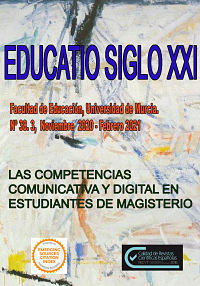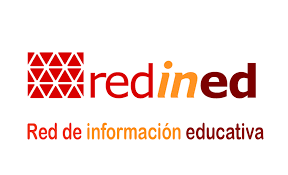Use of Evidence and Historical Significance when Teaching the Spanish Transition to Democracy by means of a Digital Learning Environment
Abstract
INTRODUCTION. This study, which is framed within the HISREDUC Project, presents the results obtained following an intervention with 15-year-old secondary education History students. METHOD. The aim of this paper is the development of two main concepts related to historical thinking (use of evidence and historical significance) through the use of a digital learning environment over seven sessions. 53 students participated and the curricular framework used was the Spanish transition to democracy. The level of progression related to both concepts is examined through a qualitative method which compared the perceived proficiency level before and after the use of the digital learning environment. RESULTS. The results allow to identify common patterns related to students’ abilities, showing a positive progression related to the use of evidence and historical significance. DISCUSSION. It can be concluded that this intervention reinforced and helped made explicit latent capabilities, allowing their use in the analysis of the past.
Downloads
-
Abstract1247
-
PDF (Español (España))771
References
Carretero, M., y Bermúdez, Á. (2012). Constructing Histories. En J. Valsiner (Ed.), The Oxford Handbook of Culture and Psychology (pp. 625-648). New York: Oxford University Press.
Cercadillo, L., Chapman, A., y Lee, P. (2017). Organizing the Past: Historical Accounts, Significance and Unknown Ontologies. En M. Carretero, S. Berger, y M. Grever (Eds.), Palgrave Handbook of Research in Historical Culture and Education (pp. 553-572). London: Palgrave.
Chapman, A. (2014). «But it Might Not Just Be Their Political Views»: Using Jörn Rüsen’s «Disciplinary Matrix» to Develop Understandings of Historical Interpretation. Cadernos de Pesquisa, 9(21), 67-85.
Cohen, L., Manion, L., y Morrison, K. (2005). Research Methods in Education (5.a ed.). London: Routledge.
Corbin, J., y Strauss, A. (2015). Basics of Qualitative Research: Techniques and Procedures for Developing Grounded Theory. Thousand Oaks: SAGE Publications.
Domínguez, J. (2015). Pensamiento histórico y evaluación de competencias. Barcelona: Graó.
Gómez, C. J., Ortuño, J., y Molina, S. (2014). Aprender a pensar históricamente. Retos para la historia en el siglo XXI. Tempo e Argumento, 6(11), 5-27. doi:10.5965/2175180306112014005
González, N., Pagès, J., y Santisteban, A. (2011). ¿Cómo evaluar el pensamiento histórico del alumnado? En P. Miralles, S. Molina, y A. Santisteban (Eds.), La evaluación en el proceso de enseñanza y aprendizaje de las Ciencias Sociales (pp. 221-232). Murcia: Universidad de Murcia y AUPDCS.
Haydn, T. (2011). History Teaching and ICT. En I. Davies (Ed.), Debates in History Teaching (pp. 236-248). London: Routledge.
Hernández-Sampieri, R., Fernández-Collado, C., y Baptista-Lucio, P. (2014). Metodología de la investigación (6.a ed.). México: McGraw-Hill.
Kee, K.B. (Ed.). (2014). Pastplay: Teaching and Learning History with Technology. Ann Arbor: University of Michigan Press. doi:10.3998/dh.12544152.0001.001
Lee, P. (2005). Putting Principles into Practice: Understanding History. En M.S. Donovan y J.D. Bransford (Eds.), How Students Learn: History in the Classroom (pp. 31-78). Washington, D.C.: The National Academies Press.
Lévesque, S. (2008). Thinking Historically: Educating Students for the Twenty-First Century. Toronto: University of Toronto Press.
Lévesque, S., y Clark, P. (2018). Historical Thinking: Definitions and Educational Applications. En S. Metzger y L.M. Harris (Eds.), The Wiley International Handbook of History Teaching and Learning (pp. 119-148). Malden: Wiley.
Rüsen, J. (2005). History: Narration, Interpretation, Orientation. New York: Berghahn Books.
Sáiz-Serrano, J., y López-Facal, R. (2015). Competencias y narrativas históricas: el pensamiento histórico de estudiantes y futuros profesores españoles de educación secundaria. Revista de Estudios Sociales, (52), 87-101. doi:10.7440/res52.2015.06
Sánchez-Agustí, M., Vásquez Lara, N., y Vásquez Leyton, G. (2016). Understanding The Processes Of Transition From Dictatorship To Democracy. A Survey Among Secondary Schools Students In Chile. International Journal of Historical Learning Teaching and Research, 13(2), 23-34.
Seixas, P. (2017). A Model of Historical Thinking. Educational Philosophy and Theory, 49(6), 593-605. doi:10.1080/00131857.2015.1101363
Seixas, P., y Morton, T. (2013). The Big Six Historical Thinking Concepts. Toronto: Nelson.
Spector, J.M., Merrill, M.D., Elen, J., y Bishop, M.J. (Eds.). (2014). Technology-Based Instructional Design: Evolution and Major Trends. En Handbook of Research on Educational Communications and Technology (4.a ed., pp. 661-671). London: Springer.
Stake, R.E. (2010). Qualitative Research. Studying How Things Work. New York: The Guilford Press.
Stoel, G.L., van Drie, J., y van Boxtel, C. (2017). The Effects of Explicit Teaching of Strategies, Second-Order Concepts, and Epistemological Underpinnings on Students’ Ability to Reason Causally in History. Journal of Educational Psychology, 109(3), 321-337. doi:10.1037/edu0000143
Van Boxtel, C., y van Drie, J. (2018). Historical Reasoning: Conceptualizations and Educational Applications. En S. Alan Metzger y L.M. Harris (Eds.), The Wiley International Handbook of History Teaching and Learning (pp. 149-176). New York: Wiley-Blackwell.
VanSledright, B.A. (2004). What Does It Mean to Think Historically... and How Do you Teach It? Social Education, 68(3), 230-233.
VanSledright, B.A., y Limón, M. (2006). Learning and Teaching Social Studies: A Review of Cognitive Research in History and Geography. En P.A. Alexander y P.H. Winne (Eds.), Handbook of Educational Psychology (2.a ed., pp. 545-570). New York: Routledge.
Wineburg, S. (2001). Historical Thinking and Other Unnatural Acts: Charting the Future of Teaching the Past. Philadelphia: Temple University Press.
Wineburg, S., Martin, D., y Monte-Sano, C. (2013). Reading Like a Historian. Teaching Literacy in Middle & High School History Classrooms. New York: Teachers College Press.

This work is licensed under a Creative Commons Attribution-NonCommercial-NoDerivatives 4.0 International License.
Original work publishes in this journal is subject to the following terms:
1. Murcia University Press (the publishing house) holds the copyright of the publishes work, and favours and allows their reutilization under the use license stated in point 2.
© Servicio de Publicaciones, Universidad de Murcia, 2015
2. Work is published in the electronic edition under a license (Creative Commons Reconocimiento-NoComercial-SinObraDerivada 4.0 España (legal text). They can be copied, used, disseminated, transmitted and publicly presented, as long as: i) authorship and original publication source is acknowledged (journal, publishing house and URL of the work); ii) are not used for commercial purposes; iii) the existence and specifications of this use license is stated.
3. Conditions for self-archive. Authors are allowed and encouraged to disseminate electronically the pre-pint (before review) and/or post-print (accepted for publication) versions of their work before their publication since that favours earlier circulation and dissemination resulting in an increased chance for the authors to be cited and for the work to reach a bigger share of the academic community. Colour: RoMEO: green.








